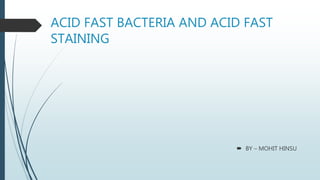
Acid fast bacteria and acid fast staining
- 1. ACID FAST BACTERIA AND ACID FAST STAINING BY – MOHIT HINSU
- 2. INTRODUCTION In nature many microorganism are present, they have some special characters. Generally bacteria stained by simple staining method like gram staining , bur some bacteria are not stained by this type of staining method or procedure , like Acid fast bacteria. WHY ACID FAST BACTERIA ARE NOT STAINED BY SIMPLE STAINING METHOD? Acid-fast bacteria, also known as acid-fast bacilli or simply AFB, is a group of bacteria sharing the characteristic of acid fastness. Acid fastness is a physical property that gives a bacterium the ability to resist decolorization by acids during staining procedures. This means that once the bacterium is stained, it cannot be decolorized using acids routinely used in the process. This important and unique feature of certain bacteria gives us the ability to classify and detect them using relatively easy laboratory procedures such as microscopy.
- 3. This type acid fast bacteria have waxy covering on the surface. If anyhow they get stained they don’t get decolorized even by strong decolorizing agent , This type bacteria called acid fast bacteria. For this type bacteria required a special type of staining method, we use acid fast staining method to Distinguish acid fast bacteria to non acid fast bacteria. It is the differential staining techniques which was first developed by Ziehl and later on modified by Neelsen. So this method is also called Ziehl-Neelsen staining techniques. Neelsen in 1883 used Ziehl’s carbol-fuchsin and heat then decolorized with an acid alcohol, and counter stained with methylene blue. Thus Ziehl-Neelsen staining techniques was developed. The main aim of this staining is to differentiate bacteria into acid fast group and non-acid fast groups. This method is used for those microorganisms which are not staining by simple or Gram staining method, particularly the member of genus Mycobacterium, are resistant and can only be visualized by acid-fast staining.
- 4. PRINCIPLE OF ACID FAST STAINING When the smear is stained with Ziehl-Neelsen carbol fuchsin[ZNCF], it solubilizes the lipoidal material present in the Mycobacterial cell wall but by the application of heat, Ziehl-Neelsen carbol fuchsin further penetrates through lipoidal wall and enters into cytoplasm. Then after all cell appears red. Then the smear is decolorized with decolorizing agent (3% HCL in 95% alcohol) but the acid fast cells are resistant due to the presence of large amount of lipoidal material in their cell wall which prevents the penetration of decolorizing solution. The non-acid fast organism lack the lipoidal material in their cell wall due to which they are easily decolorized, leaving the cells colorless. Then the smear is stained with counterstain, methylene blue. Only decolorized cells absorb the counter stain and take its color and appears blue while acid-fast cells retain the red color.
- 5. Structure of an Acid-Fast Cell Wall
- 6. Requirement Primary Stain: Ziehl-Neelsen carbol fuchsin [ZNCF] Decolorization Solution: Acid alcohol Counterstain: Methylene blue Why is Ziehl-Neelse carbol Fuchsin used in acid fast staining? -Carbol fuchsin is used as the primary stain dye to detect acid-fast bacteria because it is more soluble in the cells wall lipids than in the acid alcohol.
- 7. PROCEDURE: 1.Prepare and fix the specimen smear prior to staining. 2.Place a small strip of blotting or filter paper over the top of the specimen, and place the slide over a boiling hot water bath on a mesh surface. 3.Cover the filter paper with the primary stain, carbolfuchsin. Leave the slide on the water bath for 3 to 5 minutes. Continue to apply stain if the filter paper begins to dry. 4.Remove the filter paper and rinse the slide with water until the solution runs clear. 5.Run acid-alcohol decolorizer over the slide for approximately 10 to 15 seconds. 6.Rinse the slide with water. 7.Cover the smear with the secondary or counterstain, methylene blue, for 1 minute. 8.Gently rinse the slide with water. 9.Blot the slide dry with bibulous paper.
- 8. Summary of Acid-Fast Stain Application of Reagent Cell colour Acid fast Non-acid fast Primary dye Ziehl-Neelsen carbon fuchsin Red Red Decolorizer Acid alcohol Red Colorless Counter stain Methylene blue Red Blue
- 9. Result Interpretation of Acid Fast Stain Acid fast: Bright red to intensive purple, Red, straight or slightly curved rods, occurring singly or in small groups, may appear beaded Non-acid fast: Blue color; In addition, background material should stain blue.
- 10. What is the purpose of the acid fast stain? The acid-fast stain is a laboratory test that determines if a sample of tissue, blood, or other body substance is infected with the bacteria that causes tuberculosis (TB) and other illnesses. Belove acid fast bacteria example given. Eg. Genus Mycobacterium – M. leprae, M. Tuberculosis, M. smegmatis, M. Avium complex, M. kansasii. Genus Nocardia – N. brasiliensis, N. cyriacigeorgica, N.